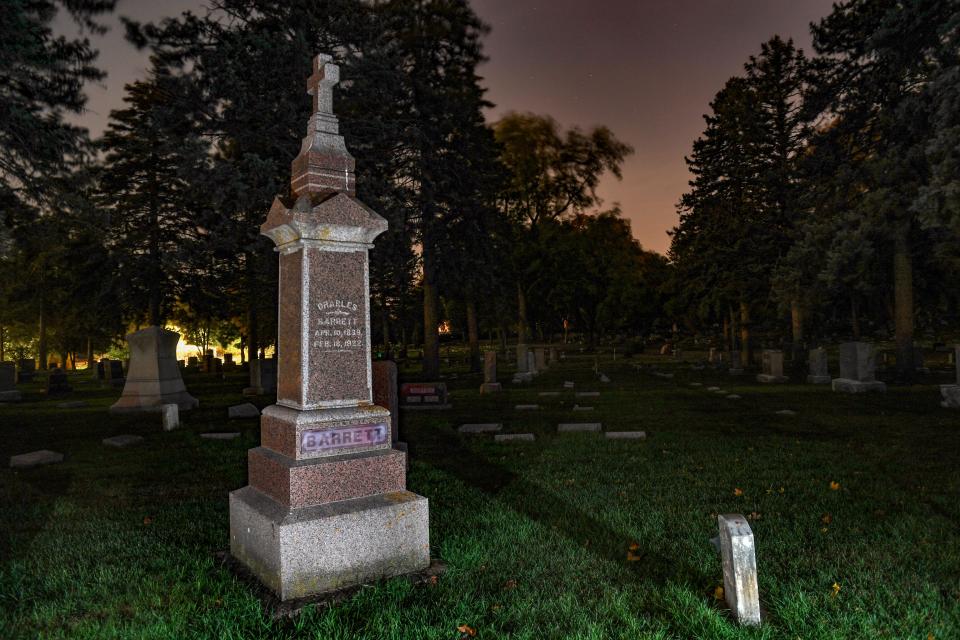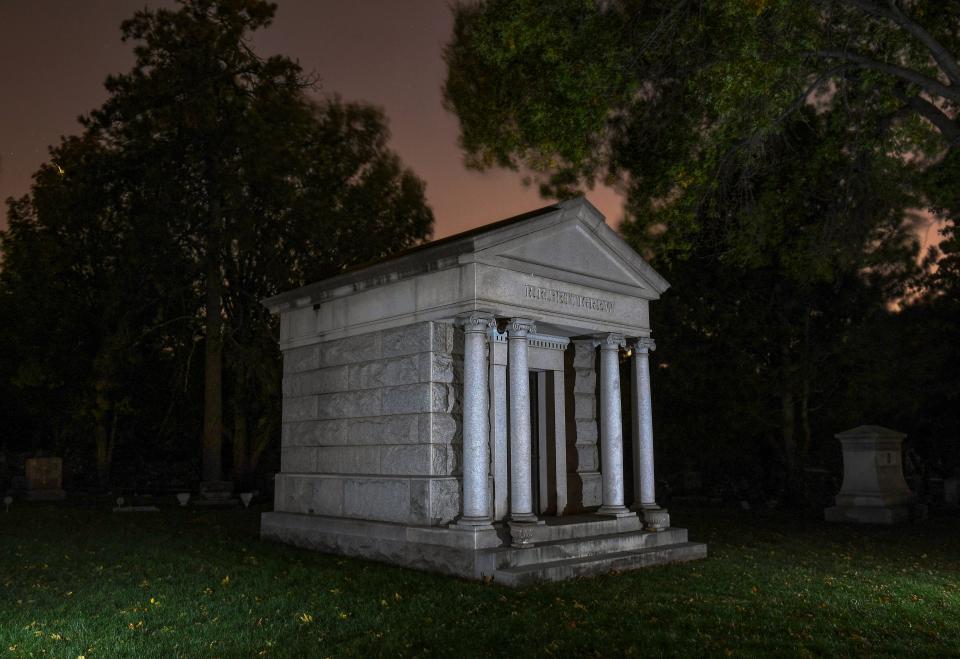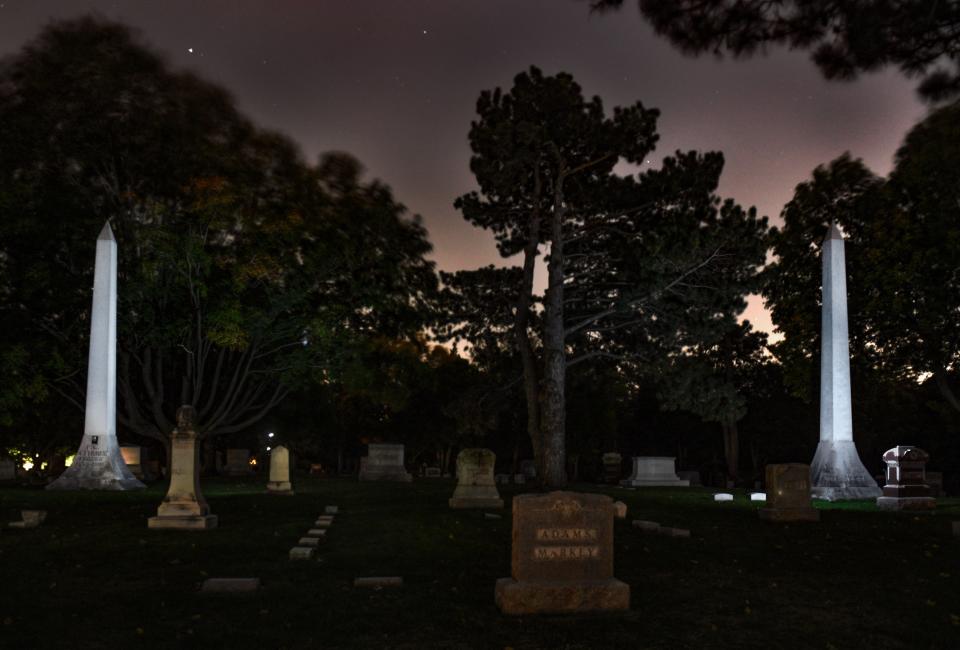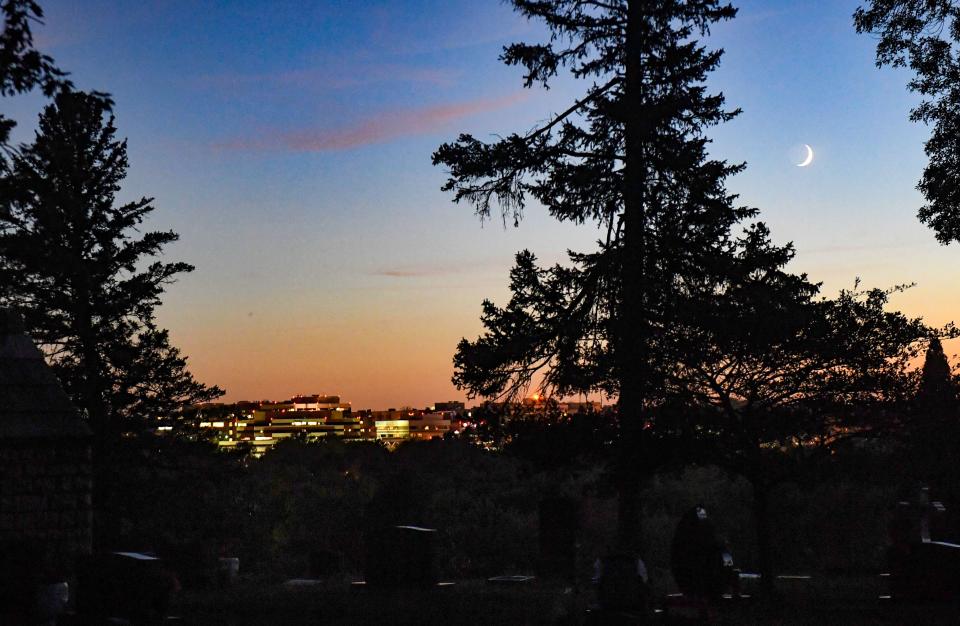What tales do the dead speak of in Sioux Falls?

Cemeteries tend to be a place of quiet reflection. Stone benches sometimes double as headstones and meandering paths let families walk among the ones who have passed on. As the wind blows and leaves rustle, visitors can almost hear the whispers of those once part of the community.
Sioux Falls has a rich history. Those who made the city what it is and who saw its true potential still remain in the cemeteries across the area: Mount Pleasant Cemetery, Woodlawn Cemetery and Hills of Rest Cemetery. The past, present and the future collide in these greenspaces filled with the red and gold changing leaves fluttering among the resting community.
In a new Argus Leader project, “Dead Men Do Tell Tales,” we seek out the hidden and well-known stories of our community and what those who’ve passed on can still teach us today. While walking through graveyards can be spooky in the fall, one can never be sure if that leaf moved because of the wind or because of a restless spirit. Regardless, the moment offers a chance for reflection.
In what's a four-part collection, this effort tells the tales of the men and women who still leave their impressions on Sioux Falls.
“Each of these people have a story, and their story is the community’s story,” said Bill Hoskins, the museum director of the Siouxland Heritage Museums, while walking among the newer headstones in Woodlawn. “They all have stories and all those threads go to make up what is the fabric of our heritage. It really helps make the community what it is today.”
MORE FROM THIS PROJECT:
Abandoned cemeteries board:Who takes care of the Sioux Falls area's oldest graves?
A history of racism: How race plays into the history of Sioux Falls cemeteries, from grave placement to record keeping
Graveyards' future: What will Sioux Falls cemeteries look like as the city grows and burial practices change?
The oldest graves in one of the oldest cemeteries
Across most of the cemeteries in Sioux Falls you’ll find Civil War veterans and Dakota Territory soldiers who made the once tiny prairie city their home.
Some of the oldest graves in Sioux Falls are four Fort Dakota soldiers resting in Mount Pleasant. Originally, the graves were in a national cemetery located near present-day 7th Street and Duluth Avenue.
Pvt. Fred Pues, Pvt. John Martin, Cpl. Jacob Luchsinger and Pvt. Fred Kohlhauff died while serving at Fort Dakota between 1866 and 1869. Their bodies were moved to Mount Pleasant in 1881 by R.F. Pettigrew.
“The legend goes that Pettigrew went and got the money from Washington to move the soldiers that were in that cemetery toward the [Big Sioux] river and one of the forts,” said Matt Gage, the sexton at Mount Pleasant. “He moved one out to the forts and everybody else came here, and he pocketed the change because it was cheaper to move them here.”
Mount Pleasant wasn’t officially opened until 1873, making it one of the oldest continuously operating cemeteries in the state, Gage said.

Two brushes with death
Charles Barrett, a private in the 46th Illinois Volunteer Infantry from 1861-1862, was one of the Civil War settlers. He moved to Sioux Falls in 1878 and worked in real estate and was also a farmer.
Barrett, who’s buried in Woodlawn Cemetery along with his family, had two brushes with death. The first, during the Civil War when he was shot in the hip during a battle in Shiloh, Tennessee, and left for dead. He was found a day later and was carried to a field hospital. The bullet was removed six years later.
Hoskins, who provided the tour at Woodlawn, explained Barrett had his second brush with death after a bit too much to drink in 1888, following the election of President Benjamin Harrison.
More:Spooky season: Spirit Halloween, seasonal stores open in The Empire Mall
“[Charles] was celebrating in a bar downtown and got hungry,” Hoskins said. “He aimed for the restaurant across the road, missed the restaurant and went into Booth’s undertaking.”
Charles Vassar Booth, the funeral director at the Phillips Avenue funeral home at the time, got Barrett situated in the back and left him to rest, Hoskins said.
Until Barrett woke up.
“He freaks out,” Hoskins said. “Charlie Booth is trying to calm him down. He’s ripping things up, jumps out the back window in the alley, running down the street saying ‘Booth is trying to bury me alive!’”
Barrett lived another 34 years until he died of cancer in 1922.

R.F. Pettigrew ‘will make one of the finest cemeteries in the country’
On an early morning in June 1903, theSioux Falls Daily Press announced that R.F Pettigrew, one of the first senators for the state, bought 70 acres of land near Hunter’s grove for “a cemetery and no more beautiful spot or one having a finer prospect could have been selected for the purpose.”
He paid J.T. Lunn $8,750, what's worth roughly $295,000 in 2022, for the area off of 26th Street and Cliff Avenue.
Woodlawn Cemetery officially incorporated in 1905 and the first burial, that of Mary Frantz, took place in March 1906.
Pettigrew also built two obelisks for his brother Fred and friend C.K. Howard, and a small family mausoleum, made out of Vermont marble, an homage to his Vermont birthplace.

For Howard, the inscription at the base of the obelisk reads “Pioneer Merchant 1838-1919.”
“C.K. Howard became the first post suttler for Fort Dakota, and a suttler is the civilian licensed by the Army to sell stuff to the Army,” Hoskins said. “He owned the suttler store and when the army abandoned Fort Dakota in 1869, Howard stayed so he is literally the first merchant in the city.”
Looking over a legacy
Helen McKennan, who was once one of the wealthiest women in Sioux Falls, is known for endowing the land that later became McKennan Park in 1906 when she died.
She and her family are buried at Mount Pleasant. Her grave, a large stone obelisk-style marker, sits on a ridgeline.
“When you stand at her grave, you literally see McKennan Hospital and McKennan Park would be right behind it,” Gage said. “Her grave overlooks her legacy of the city.”
At the time of her death, McKennan left $25,000 to her personal physician Edwin Perkins to establish McKennan Hospital, which later became Avera. Plans for McKennan Park were already in motion.

Death by electrocution and an unmarked grave
Each graveyard has its own gruesome stories. At Hills of Rest, in an unmarked grave near a large pine tree, lies George Sitts, who died at 33 in 1947 at the South Dakota State Penitentiary in Sioux Falls.
Sitts was and remains the only man put to death by electrocution in South Dakota. He was found guilty of killing three people, two South Dakota law enforcement officers in 1946 after he escaped jail in Minneapolis, where he was being held forhis conviction in the 1945 slaying of a Minnesota store clerk.
Sitts had no family to claim his body and arrangements had been made for him to be buried in an unmarked grave somewhere in Minnehaha County, according to Argus Leader archives. His eyes were removed and sent to an eye bank in New York.
More:Family-friendly Sioux Falls Halloween events from trick-or-treating to a Zombie Walk
What’s unique about Sitts’s final resting place, Phil Schmitz, the manager of Hills of Rest, said is that Sitts’s wooden casket is sinking because a vault wasn’t constructed at the time, because the metal that was used was going toward the Second World War effort.
“We come back and fill these in periodically,” Schmitz explained.
Hills of Rest had the location of Sitts's burial plot in their records even though there is no marker.
This article originally appeared on Sioux Falls Argus Leader: What do Sioux Falls' cemeteries tell residents about the past?

